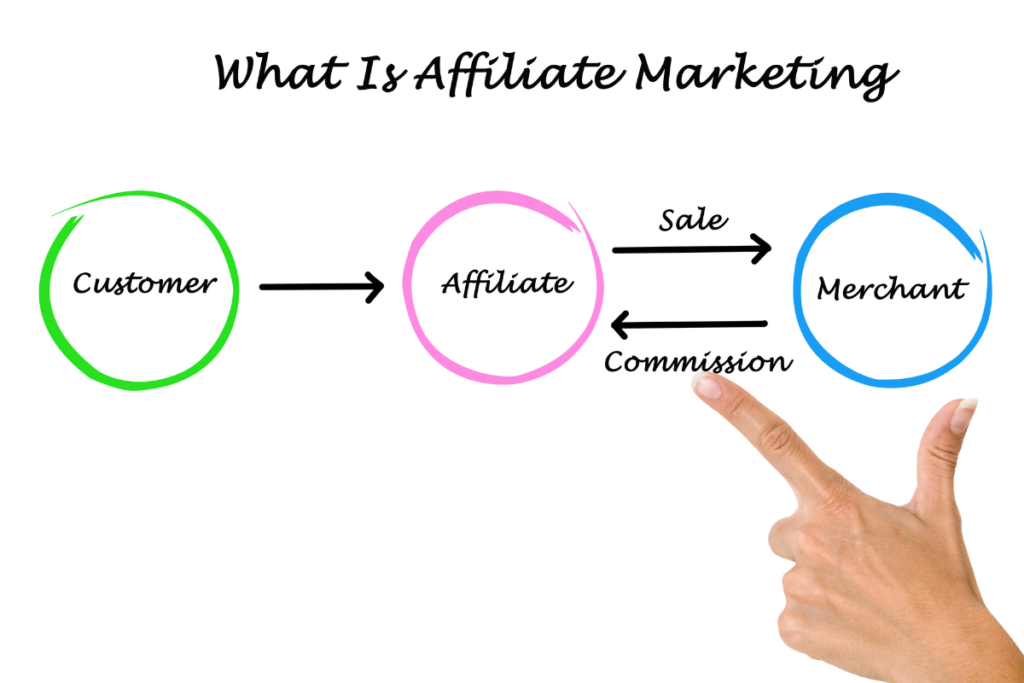Affiliate Marketing for Beginners: Step-By-Step Guide to Boost Your Online Income
Affiliate marketing is a great way for people and businesses to make money. You promote other companies’ products or services and earn a commission for each sale made through your referral link. Although it might seem complicated, it’s quite easy to get started. This guide will provide a simple step-by-step approach to successful affiliate marketing in 2024.
Table of Contents
Understanding the Affiliate Marketing

Affiliate marketing is when a company pays someone else to promote its products or services and gives them a commission for any sales made through their referral. For instance, a travel blogger can promote hotel websites and earn money when people book rooms through their links.
The beauty of affiliate marketing lies in its simplicity. You don’t need to create your own products or handle customer service. You simply promote existing products and services, and you get paid a commission for every sale you drive through your unique referral link.
Here is a simple step-by-step guide for beginners on how to make money with affiliate marketing:
Step 1: Building Your Audience
Successful affiliate marketing relies on having a loyal audience. It’s essential to attract individuals who are genuinely interested in the products or services you’re promoting. Building this dedicated following ensures that your recommendations resonate, increasing the likelihood of conversions and generating more income through your affiliate links.
Choosing a Niche
Instead of promoting every product under the sun, focus on a specific niche. This allows you to become an expert in a particular area and cater your content to a targeted audience. For example, if you choose “health” as your niche, you can focus on promoting products related to fitness, nutrition, or supplements.
Creating Content on Social Media
Your audience needs a reason to follow you and trust your recommendations. This is where quality content comes in. Create blog posts, videos, podcasts, or social media content that provides value to your audience.
Using social media for affiliate marketing can be highly effective. Share your content on platforms like Instagram, Facebook, Twitter, and Pinterest. Use eye-catching images, videos, and posts to attract followers. Interact with your audience by responding to comments and messages to build trust. Utilize hashtags and trends to increase visibility. Track your performance to see what works best. Adjust your strategies based on your results to maximize reach.
Creating Video Content
Video content is highly engaging and popular in today’s digital landscape. Creating high-quality videos can attract a wider audience and establish you as a thought leader.
- Experiment with different video formats: Try explainer videos, product reviews, tutorials, or behind-the-scenes content.
- Use compelling visuals and sound: Invest in quality equipment and software to create visually appealing and professionally produced videos.
- Optimize for search engines: Use relevant keywords in your video titles and descriptions to improve visibility on platforms like YouTube.
Step 2: Finding the Right Affiliate Programs

Affiliate marketing is a method where affiliates earn money by promoting a merchant’s products or services. They receive a commission whenever their efforts lead to someone visiting the merchant’s website, signing up for something, or making a purchase.
Identifying Affiliate Programs
Use search engines: First, use search engines to find affiliate programs. Search for terms related to your niche along with “affiliate program” or “affiliate marketing.” This way, you can find many options, from big platforms like Amazon Associates, Impact, and Fiverr Affiliates to smaller programs focused on specific interests. Here are some of the affiliate programs.
Explore niche-specific marketplaces:
Next, check out specialized websites for affiliate programs. Sites such as ClickBank, ShareASale, and CJ Affiliate bring together programs from different industries. They organize programs by specific interests, helping you find products or services that match what your audience likes.
Contact companies directly:
You can also reach out to companies directly for affiliate opportunities. Visit their website and check for an “Affiliates” or “Partnerships” section. If you don’t find one, send an email or call them to ask about affiliate programs. Taking this proactive step can help you secure unique partnerships and potentially negotiate better commission rates that are not widely advertised. It’s a direct way to explore opportunities that may not be easily found through online searches or affiliate marketplaces.
Step 3: Integrating Affiliate Links
After joining affiliate programs, include your special affiliate links in your content to earn commissions when people click them and make purchases or sign up for services.
Tips for Integrating Affiliate Links
- Provide value first: First, offer valuable content and recommendations to your audience. Avoid spamming them with affiliate links. Integrate your links naturally after providing helpful information, ensuring they fit well within your content without seeming intrusive or overly promotional.
- Use clear calls to action: Encourage your audience to take action by specifying what you want them to do, like clicking to learn more or checking out a product.
- Use shorteners: Use URL shorteners to make your links shorter and look better, making it easier and more attractive for people to click on them.
Step 4: Promoting Your Affiliate Links

After integrating your affiliate links, it’s time to promote them to your audience.
Effective Promotion Strategies
- Social Media: Leverage the power of social media to share your affiliate links across various platforms, such as Facebook, Twitter, Instagram, and Pinterest. Create engaging posts that highlight the benefits of the products you’re promoting. Use eye-catching visuals and compelling captions to grab your audience’s attention. Don’t forget to include your affiliate links and encourage your followers to click through. Engaging with your audience through stories, live sessions, or polls can also increase interaction and drive traffic to your links.
- Email Marketing: Build and maintain an email list to promote your affiliate products directly to your subscribers. Craft informative and persuasive newsletters that highlight special offers, new product launches, or exclusive discounts. Personalize your emails to resonate with your audience, and include clear calls-to-action that guide recipients to your affiliate links. Regular communication through email helps build trust with your subscribers and increases the likelihood of them purchasing through your links.
- Website or Blog: Integrate affiliate links naturally within your website or blog content. Whether you’re writing blog posts, product reviews, or creating resource pages, ensure the affiliate products align with your content and audience interests. Provide valuable insights, tips, or comparisons that make your recommendations trustworthy. Clear, compelling calls-to-action can encourage readers to click your links, leading to higher conversion rates.
- Community Engagement: Actively participate in online forums, communities, and niche-specific groups where your target audience hangs out. Engage in discussions, provide helpful insights, and build relationships with members. When appropriate, share your affiliate links in a way that adds value to the conversation. Avoid spamming; instead, focus on being a genuine contributor. This organic approach can effectively promote your affiliate links while establishing your authority within the community.
Step 5: Tracking Your Results
Tracking your affiliate marketing efforts is important to see what’s effective and where you can make improvements.
Using Affiliate Marketing Tools
Affiliate Network Dashboards: Take full advantage of the dashboards offered by affiliate networks. These platforms provide valuable insights into your performance metrics, including clicks, conversions, and earnings. By regularly checking these statistics, you can identify trends, understand which products resonate with your audience, and adjust your strategies accordingly to maximize your income.
Analytics Tools: Implement website analytics tools like Google Analytics to gain a deeper understanding of your website’s traffic flow. These tools help you track visitor behavior, such as where they come from, which pages they visit, and how long they stay. By analyzing this data, you can determine which affiliate links are performing well and optimize your content for better engagement and conversions.
Google Search Console: Utilize Google Search Console to monitor your website’s performance in search engine results pages. This tool allows you to see how your site ranks for specific keywords, track clicks and impressions, and identify any issues affecting your visibility. By making necessary adjustments based on this information—such as improving your content or fixing broken links—you can enhance your site’s SEO performance, attract more visitors, and ultimately increase your affiliate marketing success.
Step 6: Refining Your Strategy

As you monitor your outcomes, you’ll find chances to enhance your methods. Here are tips for continually improving your approach.
- Optimize Your Content: Update your content regularly to reflect the latest trends and adapt to your audience’s needs.
- Experiment with Different Promotion Methods: Try new strategies to reach a wider audience and test different approaches to see what works best for your niche.
- Focus on User Experience: Ensure your website, blog, or social media pages are user-friendly and provide a seamless experience for visitors.
- Stay Updated: The affiliate marketing landscape is constantly changing. Stay informed about new trends, platforms, and tools to stay ahead of the curve.
Building a Sustainable Affiliate Marketing Business
Affiliate marketing can be a profitable and rewarding endeavor. By following this roadmap, you can build a strong audience, choose the right affiliate programs, create engaging content, and promote your affiliate links effectively. Remember, patience, persistence, and continuous improvement are key to success in this dynamic field. Start building your affiliate marketing business today and watch your income grow.
What is affiliate marketing?
Affiliate marketing is a performance-based marketing strategy where individuals earn commissions by promoting products or services from other companies. Affiliates receive a unique link to track sales and clicks, allowing them to earn money for each successful referral.
Do I need a website to start affiliate marketing?
While having a website or blog is highly beneficial for affiliate marketing, it’s not strictly necessary. You can promote affiliate links through social media, email marketing, or platforms like YouTube. However, a dedicated website can help you build authority and attract a larger audience.
How do I choose the right affiliate programs?
When selecting affiliate programs, consider your niche, the quality of the products, and the commission structure. Look for programs that align with your audience’s interests and offer reliable tracking, timely payouts, and good support.
How much can I earn through affiliate marketing?
Earnings in affiliate marketing vary widely based on factors such as your niche, traffic, and marketing strategies. Beginners may earn a few hundred dollars a month, while more experienced marketers can make thousands. Ultimately, your dedication and efforts will influence your income potential.
What are some effective ways to promote affiliate products?
Effective promotion methods include creating engaging blog content, utilizing social media, leveraging email marketing, and participating in relevant online communities. Focus on providing value to your audience by sharing honest reviews, tips, and recommendations related to the affiliate products you promote.







